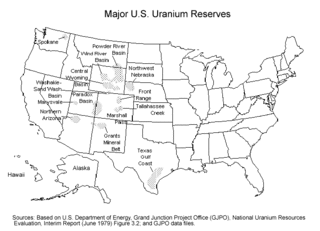Related Research Articles

The uranium market, like all commodity markets, has a history of volatility, moving with the standard forces of supply and demand as well as geopolitical pressures. It has also evolved particularities of its own in response to the unique nature and use of uranium.

Uranium mining is the process of extraction of uranium ore from the ground. Over 50 thousand tons of uranium were produced in 2019. Kazakhstan, Canada, and Australia were the top three uranium producers, respectively, and together account for 68% of world production. Other countries producing more than 1,000 tons per year included Namibia, Niger, Russia, Uzbekistan, the United States, and China. Nearly all of the world's mined uranium is used to power nuclear power plants. Historically uranium was also used in applications such as uranium glass or ferrouranium but those applications have declined due to the radioactivity of uranium and are nowadays mostly supplied with a plentiful cheap supply of depleted uranium which is also used in uranium ammunition. In addition to being cheaper, depleted uranium is also less radioactive due to a lower content of short-lived 234
U and 235
U than natural uranium.
The McArthur River Uranium Mine, in northern Saskatchewan, Canada, is the world's largest high-grade uranium deposit.

Krasnokamensk is a town and the administrative center of Krasnokamensky District in Zabaykalsky Krai, Russia, located near the Sino-Russian border, 535 kilometers (332 mi) southeast of Chita, the administrative center of the krai. It is best known as the site for Russia's largest uranium mine. Population: 55,666 (2010 Census); 55,920 (2002 Census); 66,872 (1989 Census).

National Atomic Company Kazatomprom Joint Stock Company (Kazatomprom) (Kazakh: Қазатомөнеркәсіп, romanized: Qazatomónerkásip) is the world’s largest producer and seller of natural uranium, providing over 40% of global primary uranium supply in 2019 from its operations in Kazakhstan. Kazatomprom's uranium is used for the generation of nuclear power around the world.

Uranium mining in the United States produced 173,875 pounds (78.9 tonnes) of U3O8 in 2019, 88% lower than the 2018 production of 1,447,945 pounds (656.8 tonnes) of U3O8 and the lowest US annual production since 1948. The 2019 production represents 0.3% of the anticipated uranium fuel requirements of the US's nuclear power reactors for the year.
Energy in Kazakhstan describes energy and electricity production, consumption and import in Kazakhstan and the politics of Kazakhstan related to energy.

Uranium One is an international group of companies, part of the management circuit of the TENEX Group of Rosatom State Corporation. Since 2013, it is a wholly owned subsidiary of Moscow-based Uranium One Group, a part of the Russian state-owned nuclear corporation Rosatom.
The mineral industry of Russia is one of the world's leading mineral industries and accounts for a large percentage of the Commonwealth of Independent States' production of a range of mineral products, including metals, industrial minerals, and mineral fuels. In 2005, Russia ranked among the leading world producers or was a significant producer of a vast range of mineral commodities, including aluminum, arsenic, cement, copper, magnesium compounds and metals, nitrogen, palladium, silicon, nickel and vanadium.

The mineral mining industry is a crucial piece of the Economy of Niger. Exports of minerals consistently account for 40% of exports.

Canada is the world's second-largest producer of uranium, behind Kazakhstan. In 2009, 20% of the world's primary uranium production came from mines in Canada. 14.5% of the world production came from one mine, McArthur River. Currently, the only producing area in Canada is northern Saskatchewan, although other areas have had active mines in the past.
The world's largest producer of uranium is Kazakhstan, which in 2019 produced 43% of the world's mining output. Canada was the next largest producer with a 13% share, followed by Australia with 12%. Uranium has been mined in every continent except Antarctica.

Mining is important to the national economy of Mongolia. Mongolia is one of the 29 resource-rich developing countries identified by the International Monetary Fund and exploration of copper and coal deposits are generating substantial additional revenue. Coal, copper, and gold are the principal reserves mined in Mongolia. Several gold mines are located about 110 kilometres (68 mi) north of Ulaanbaatar, such as Boroo Gold Mine and Gatsuurt Gold Mine. Khotgor Coal Mine is an open-pit coal mining site about 120 kilometres (75 mi) west of Ulaangom. Ömnögovi Province in the south of Mongolia is home to large scale mining projects such as the Tavan Tolgoi coal mine and the Oyu Tolgoi copper mine. Oyu Tolgoi mine is reported to have the potential to boost the national economy by a third but is subject to dispute over how the profits should be shared. The International Monetary Fund (IMF) has estimated that 71 percent of the income from the mine would go to Mongolia.
The Elkon mine is a large open pit mine in the eastern part of Russia in Sakha Republic. Elkon represents one of the largest uranium reserves in Russia having estimated reserves of 219.2 million tonnes of ore grading 0.15% uranium.
The Dalmatovskoye mine is a large open pit mine located in the southern part of Russia in Kurgan Oblast. Dalmatovskoye represents one of the largest uranium reserves in Russia having estimated reserves of 25.5 million tonnes of ore grading 0.04% uranium.

The Streltsovsk mine is a large open pit mine located in the southern part of Russia in Zabaykalsky Krai. Streltsovsk represents one of the largest uranium reserves in Russia having estimated reserves of 64.1 million tonnes of ore grading 0.2% uranium.
The Olovskoye mine is a large open pit mine located in the southern part of Russia in Zabaykalsky Krai. Olovskoye represents one of the largest uranium reserves in Russia having estimated reserves of 16.8 million tonnes of ore grading 0.082% uranium.
The Imouraren mine is a large mine located in the northern part of Niger in Agadez Region, about 80 km (50 mi) south of Arlit. Imouraren represents one of the largest uranium reserves in Niger having estimated reserves of 109.1 million tonnes of ore grading 0.06% uranium. It is the site of a uranium mining project involving French company Areva and SOPaMin. The U3O8 ore grade at nearby SOMAIR is 14,000 tons at 0.3%, COMINAK is 29,000 t at 0.4% and Imouraren 120,000t at 0.15%.

The Moiynkum Desert, is a desert in the Turkistan and Zhambyl regions of southern Kazakhstan.
References
- ↑ "Uranium mines in Russia". wise-uranium.org. 2013. Retrieved 2013-07-07.